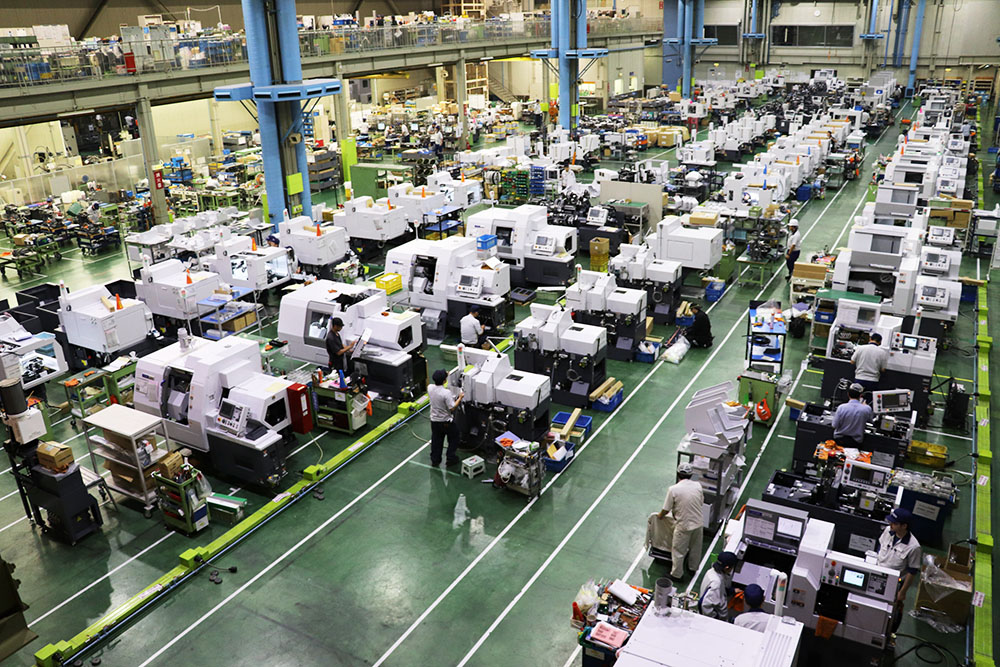
- News
- Basics
- Products
- JP Job shop
- Exhibition
- Interview
- Statistic
- PR
- Download
- Special contents
Statistic
September 1, 2023

768,437 million yen (-9.4% QoQ, -15.7% YoY)
A summary of Japan’s machine tool orders for the first half of 2023 (January-June) has been released by the Japan Machine Tool Builders’ Association (JMTBA). The total amount of orders received during January-June 2023 was 768,437 million yen. This was the second consecutive quarter-on-quarter (QoQ) decline and the first year-on-year (YoY) decline in five half-year periods. For the first half of the year, it was the first time in two years and the first time in four half-year periods, including the second half of the year, that the amount of orders received was less than 800 billion yen.
Monthly orders received were at a lower level than in the second half of 2022, due to a slowdown in demand related to semiconductors and electric vehicles. However, orders remained firm in Japan as well as in China and other Asian, European and U.S. markets.
252,083 million yen (-12.7% QoQ, -19.9% YoY)
Domestic demand declined both QoQ and YoY for the second consecutive half and for the first half of a year for the first time in three years. It was the second consecutive half (and the first time in two years for the first half of a fiscal year) that domestic orders fell below 300 billion yen.
On a monthly basis, there were some months when orders were below 40 billion yen, showing a subdued trend. In addition to the weakness in the automobile industry, demand for semiconductors also seems to have been affected by the slowdown in momentum. On the other hand, the effect of subsidies helped prevent a sharp decline in demand.
By industry, 10 out of 11 industries reported a decline in QoQ, while 9 industries reported a decline in YoY. Aircraft/Shipbuilding/Transport equipment increased both QoQ and YoY, while Electrical & Precision Machinery, which is mainly related to semiconductors, and automotive-related industries, which lack momentum, posted sharp declines.
| Amount (million yen) | MoM change (%) | YoY change (%) | |
| Domestic total | 252,083 | – 12.7 | – 19.9 |
| Industrial Machinery | 113,032 | – 0.8 | – 12.7 |
| Motor Vehicles | 47,805 | – 29.3 | – 28.7 |
| Electrical & Precision Machinery | 31,866 | – 16.8 | – 33.9 |
| Aircraft/Shipbuilding/Transport equipment | 10,074 | + 7.0 | + 6.7 |
516,354 million yen (-7.7% QoQ, -13.5% YoY)
Foreign demand declined both QoQ and YoY for the second consecutive half and for the first time in three years for the first half. Orders remained firm, exceeding 500 billion yen for the fourth consecutive half year (and the second consecutive first half year).
On a monthly basis, orders received were one level lower (monthly average of 86.1 billion yen in the first half of 2023) than in the second half of 2022 (monthly average of 93.2 billion yen), but orders remained high compared to past standards, and there were no major declines in any of the three major regions.
By region, the largest decrease was seen in Asia among the three major regions. On the other hand, orders from Europe increased both QoQ and YoY, and orders from North America exceeded 150 billion yen for the fourth consecutive half year, showing generally solid results, although there were some temperature differences.
In Asia, the large-scale EV-related investment seen in China in the previous year settled down and there was no EMS-related investment, leading to a larger decline, but India remained strong, especially in the automotive sector. In Europe, the region continued to move in a flat range from the second half of 2021, despite concerns about rising interest rates and geopolitical risks. North America also maintained a high levels of investment, particularly from large companies, despite concerns about financing for job shops and other businesses due to rising interest rates. In Europe and the U.S., orders may have remained firm as Japanese-made machinery is perceived as undervalued due to the weak yen.
| Amount (million yen) | MoM change (%) | YoY change (%) | |
| Foreign total | 516,354 | – 7.7 | – 13.5 |
| Asia | 229,035 | – 14.3 | – 20.9 |
| Of which East Asia | 177,195 | – 16.0 | – 24.6 |
| Of which China | 151,989 | – 16.0 | – 22.5 |
| Of which Rest of Asia | 51,840 | – 7.8 | – 5.1 |
| Europe | 118,086 | + 3.4 | + 1.0 |
| North America | 154,928 | – 6.5 | – 13.4 |